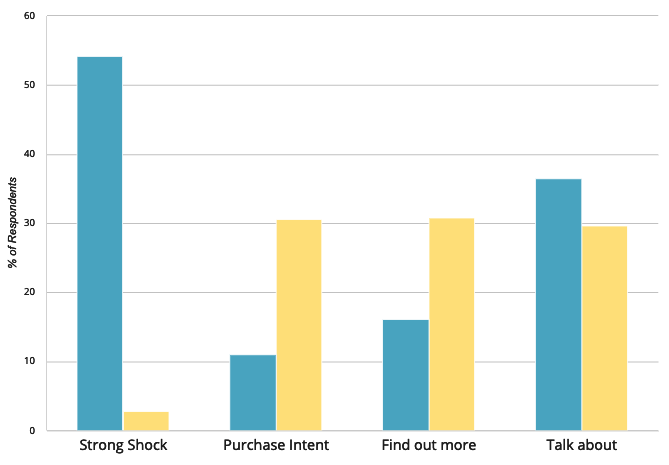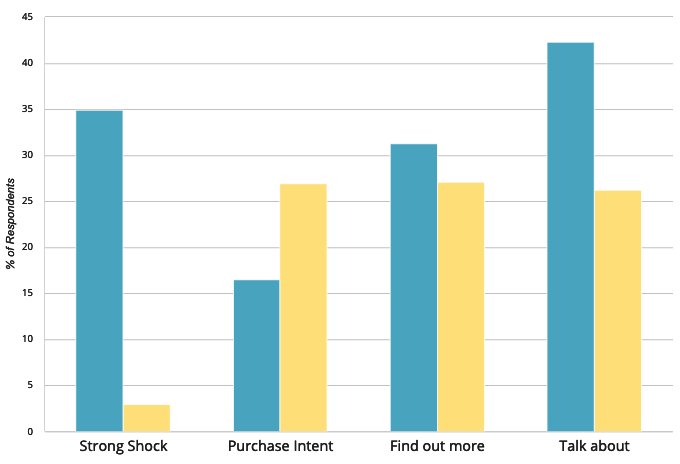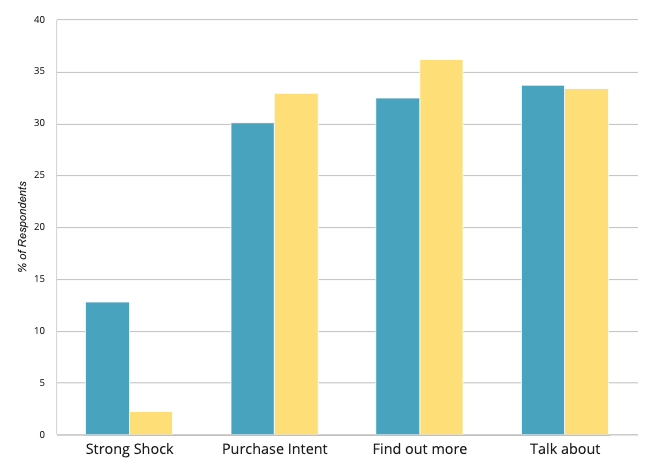Shockvertising: Dissecting the world’s most shocking ads
As part of our Emotions UNcovered: Surprise and Shock season, we’ve jumped back into our emotional database of over 2.2 million audience reactions to discover how shockvertising is used across the globe, and what effects it has on audiences.
Shock is an interesting emotion to look at when it comes to advertising as it is one of the least frequently used psychological responses, with exceptions being action and horror film trailers and public service announcements.
US – AT&T: Close to Home – It Can Wait

This harrowing ad was commissioned as part of AT&T’s Close to Home campaign which was launched back in 2016 to raise awareness of the dangers of using your phone when you drive. It was released to a polarised opinion with many respondents finding the final scenes very difficult to watch. The ad scored 48% for strong shock, which is the highest score in all the ads we’ve tested in the US.
Find out more scored 42% which is 3% over the norm, and 62% of respondents said they’d talk about the ad after compared to a norm of 38%. This is likely due to the controversial nature of the ad, and the huge shock at the end which left many viewers stunned.
UK – Think!: #PubLooShocker

This ad, which was created for the Department for Transport’s THINK! campaign, scored the highest for Shock in the UK. It was created to raise awareness of the implications of drink driving through a series of pranks in a London pub.
54% of respondents found this ad Strongly Shocking. This is likely down to the unexpected Surprise and Shock that respondents felt when the pranks were played out. Find out more was lower than the norm (16% vs. 31%) and more respondents wanted to talk about the ad than the norm (36% vs. 30%). This may be down to the fact that prank videos are extremely popular online, and the ad is conveying an important message.
It’s interesting to note that this ad worked well in getting people to talk about it, but many viewers did not feel like they needed or wanted to find out more about the implications of drink driving after seeing the ad, begging the question as to whether it delivered the desired effect.
Australia – UNICEF: A storybook wedding – except for one thing

UNICEF used shockvertising as part of a campaign they ran in 2016 to raise awareness of child marriage. At the time of the ad, 15 million girls a year were subject to child marriage, as of 2019 this figure has dropped to 12 million.
This ad evoked emotions of Shock in 35% of respondents and 32% of respondents said they wanted to find out more after seeing the ad, which is higher than the norm. This is likely down to the ad having a long build-up, and leaving viewers with a shocking statistic that encourages you to go away and find out more about why this is happening. 42% of respondents said they’d talk about the ad after viewing it compared to a 26% norm in this market, demonstrating the power that evoking Shock has on spreading awareness if it’s done in the right way.
Singapore – Bodyform: Blood

Last year, Bodyform used shockvertising in this ad which moved audiences across the globe and scooped a number of awards. In Singapore, the ad received mixed reviews, with 15% of respondents finding it shocking making it the highest scoring ad for Shock that we’ve tested in this market.
Purchase intent for this ad was just below the norm (30% vs. 33%). This may be due to the fact that the ad was poorly branded, with many viewers not knowing what company or product was behind the ad. 34% of respondents said they’d talk about the ad after viewing, compared to a norm of 33%, this is quite low compared to some of the other ads we’ve looked at. Again, this may be due to viewers not knowing what the ad is promoting, combined with scenes that some may find quite difficult to watch and not willing to share.
https://www.youtube.com/watch?v=N-yIBD7cOUg
Peter Field on Shock
New research that we conducted with the IPA and renowned marketing consultant Peter Field, reveals the link between video content and real-world outcomes.
It also found that fame correlates far more with social and Shock/Surprise responses than with emotion. The actions to share or talk about the video were the top fame metrics, followed by the cognitive responses of Surprise, and its more intense version, Shock. The majority of the remaining metrics in the top ten were social motivations.
Click here to download the study.
So how should Shock be used?
Throughout these ads, we’ve seen that shockvertising can work very well in getting audiences to talk about and share ads, this is especially true when it comes to charities and public service announcements.
A famous example of where shockvertising went wrong is in Nationwide’s Make Safe Happen ad which ran during the 2015 Super Bowl. The ad scored 13% for Sadness, and also scored highly for both Confusion and Disgust. As a result purchase intent, shareability and find out more all scored way below average. The Make Safe Happen ad disappeared from airwaves just hours after its Super Bowl debut and caused a social-networking uproar.
A great example of shockvertising going right is in GEICO’s Unskippable ad. Although Shock isn’t as high in this ad as ones we’ve previously looked at, here it’s used to evoke positive emotions like Hilarity (20%) and Happiness (19%). Lots of brands use Shock humour in their advertising to get people talking about their ads. This is often seen in the SuperBowl spots with ads like the Mountain Dew and Doritos Rap Battle from 2018 and Devour’s Food Porn Super Bowl spot from this year.
Next time you’re thinking of running a campaign where the goal is spreading awareness it might be worth thinking about how shockvertising could help you. As with all the strong cognitive and primal responses (Surprise, Knowledge, Anger, Arousal, and Fear) advertisers and brands need to ensure that Shock is used in the right context, in the right way otherwise it could have devastating effects!

